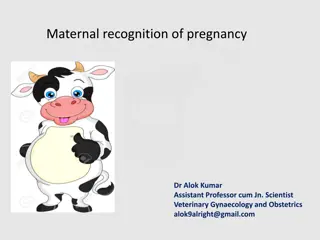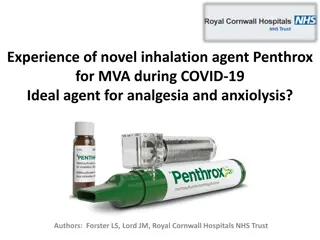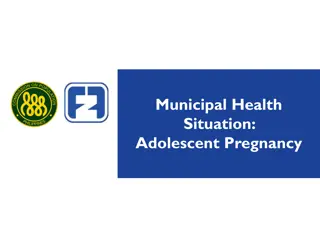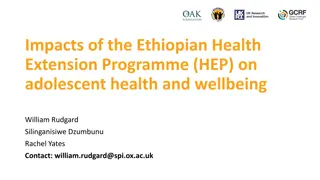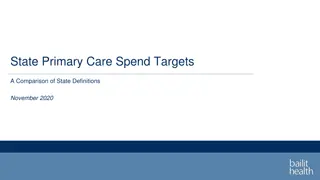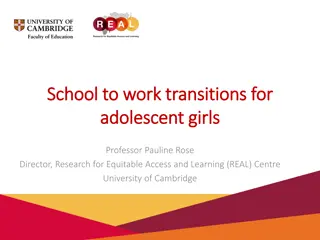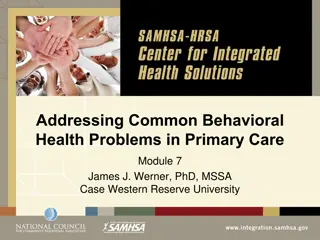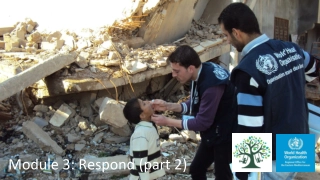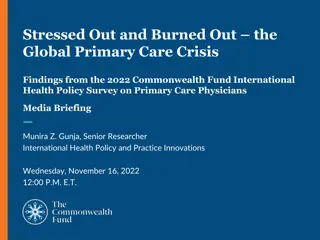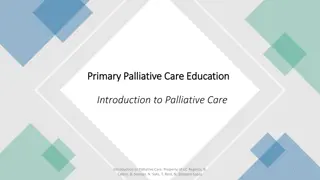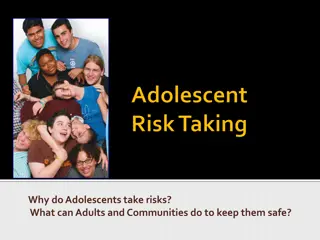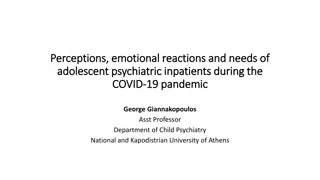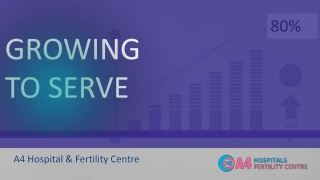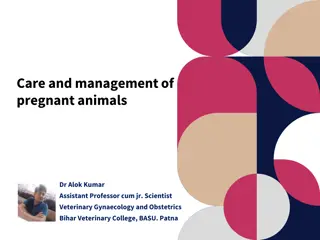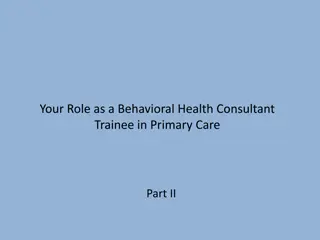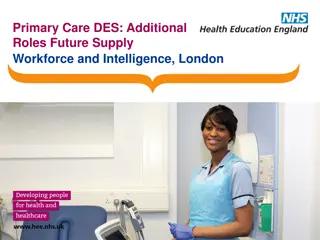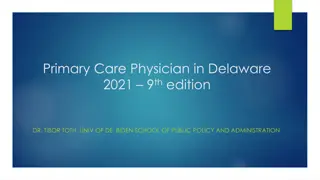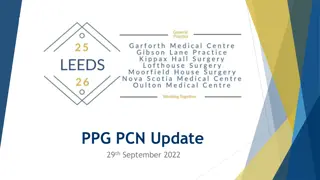Adolescent Gynaecology in Primary Care: An Overview
Dr. Emma Park, a GP trainer leading the GP CASES project in Sheffield, provides insights into adolescent gynaecology in primary care. The session emphasizes personalized care, common issues faced, and the importance of contraception and fertility concerns. Practical tips include seeing young patients alone, framing requests for screenings sensitively, and the significance of peer reviewing systems like CASES audit in ensuring appropriate care for adolescents.
Download Presentation

Please find below an Image/Link to download the presentation.
The content on the website is provided AS IS for your information and personal use only. It may not be sold, licensed, or shared on other websites without obtaining consent from the author. Download presentation by click this link. If you encounter any issues during the download, it is possible that the publisher has removed the file from their server.
E N D
Presentation Transcript
Adolescent Gynaecology What You Need to Know in Primary Care'. Dr Emma Park GP trainer Lead GP CASES project Primary Care Sheffield RCGP Adolescent Health Group epark1@nhs.net
Outline of session Why a different approach? What do we see? Overview of common problems Summary and resource slide Questions?
Why a different approach?
Adolescent Gynae First signs of many serious longterm conditions emerge at this age. Risk-taking behaviours begin, including sexual activity Life-long health behaviours are set in place Gynae problems are common but serious pathology is rare distress and discomfort can be significant.
Its all about them Care needs to be personalized to the young person in front of you Contraception may be more important than diagnosis VE/invasive investigations may be inappropriate Fertility concerns may be an issue depending on your pt s background
Top Tips Always try to see the young person by themselves Jenny will soon be a grown up and seeing me by herself so why don t we practice today Frame requests for STI screens or pregnancy tests as something we do for all young people
So, what do we see ?
CASES audit- what do we see in Primary care? Clinical Assessments, Services, Education and Support-CASES Innovative peer reviewing system in Sheffield GPSI reviews referrals to ensure the pt gets the most appropriate care Audit of all gynae referrals aged 16-25 since July 2016 in Sheffield
Primary reason for referral 45 40 35 30 25 20 15 10 5 0 Total referred back to GP
CASES Audit Why were referrals passed on? Complex problems Problems which need secondary care input! Patient/parent/GP concerns and unwillingness to pragmatically manage in the absence of a diagnosis
CASES Audit Why were referrals passed back? Conditions which can be easily managed in primary care No STI screen done Cosmetic concerns First line management not attempted
Excessive menstrual flow in its duration (>7 days) or its volume (equates to needing to change a super pad/tampon more frequently than every two hours) Bleeding causing symptomatic anaemia or lifestyle disturbance Menorrhagia
Menorrhagia- causes Menstrual cycles often irregular in the first years after menarche Most are caused by anovulatory cycles related to immaturity of the hypothalamic-pituitary-ovarian axis. Other causes include pregnancy, infection, the use of hormonal contraceptives, stress (psychogenic or exercise induced), under- and over-weight or weight changes Bleeding disorders are more common. Less common causes systemic illness and endocrine disorders. Structural lesions are incredibly rare (cervical polyps and uterine leiomyomas such as fibroids).
Management FBC/clotting screen If no contraception required Tranexamic acid/NSAIDS 1stline COC Depo-provera Use for 3-6mths before trying another method/referring
PCOS affects 6%- 7% of women Prevalence is higher in women of South Asian origin, who have more severe symptoms and present at a younger age Polycystic ovarian syndrome
What is PCOS ? Complex endocrine disorder Linked with insulin resistance and metabolic syndrome Cause of PCOS is unknown Likely to be multifactorial, with both genetic and environmental factors playing a part.
Rotterdam Criteria PCOS should be diagnosed if 2/3 1. Infrequent or no ovulation (usually manifested as infrequent or no menstruation). 2. Clinical or biochemical signs of hyperandrogenism (ie hirsutism, acne, or male pattern alopecia), or elevated levels of total or free testosterone. 3. Polycystic ovaries on ultrasonography, defined as the presence of 12 or more follicles in at least one ovary, measuring 2 9 mm diameter, or increased ovarian volume (greater than 10 mL). Polycystic ovaries do not have to be present to make the diagnosis, and the finding of polycystic ovaries does not alone establish the diagnosis.
Potential Pitfalls in Adolescence Follicle counts are normally high after the menarche Anovulatory cycles soon after menarche may mimic oligomenorrhea (cycles of longer than 6 to 8 wks) 1 year after menarche, most girls will have regular monthly menses, although girls who begin to menstruate after age 13 may take longer to establish a regular cycle. Oligomenorrhea at age 15 or older may be a sign of a underlying problem Remember 80% to 90% of adolescents have acne and 25% require pharmacological treatment
What do I do? Encourage a healthy lifestyle to reduce possible long-term risks to health (type 2 diabetes and cardiovascular disease). Emphasize that becoming overweight makes the condition worse. Offer regular screening for impaired glucose tolerance and type 2 diabetes. Do not initiate treatment with insulin-sensitizing drugs in primary care.
What do I do? For those with oligomenorrhoea or amenorrhoea: Exclude pregnancy Induce a withdrawal bleed with a 12day course of medroxyprogesterone Get u/s to assess endometrial thickness.. If the ET is less than 10mm, advise treatment to prevent endometrial hyperplasia. Offer either regular withdrawal bleeding at least once every 3 months (using COC or cyclical progestogen) or the mirena
Primary amenorrhoea - failure to establish menstruation by 16 years of age in women with normal secondary sexual characteristics, or by 14 years of age in women with no secondary sexual characteristics Secondary amenorrhoea - the absence of menstruation for at least 6 months in women with previously normal and regular menses, or for 12 months in women with previous oligomenorrhoea Amenorrhoea
Primary Amenorrhoea Refer for specialist investigation & management those who have no secondary sexual characteristics & who have not started menstruating by 14 years of age. those with normal secondary sexual characteristics & who have not started menstruating by 16 years of age. Growth retardation. Symptoms and signs of androgen excess (such as hirsutism) or thyroid disease & amenorrhoea. Galactorrhoea. Suspected genital tract malformation, intracranial tumour (for example prolactinoma), chromosomal anomaly (eg Turner's syndrome or androgen insensitivity), or anorexia nervosa. Puberty lasting 5 years without menarche (eg example presenting at 15 years of age when pubic hair and breast development started at 10 years of age).
Secondary Amenorrhoea Manage in primary care: Polycystic ovary syndrome Hypothyroidism menses may take several months to resume with treatment. Pregnancy Refer to a gynaecologist Elevated FSH/LH x2 which suggests premature ovarian failure in women younger than 40 years of age. Recent history of uterine/cervical surgery/pelvic infection- Asherman's syndrome or cervical stenosis.
Secondary Amenorrhoea Refer to an endocrinologist Hyperprolactinaemia: serum prolactin level greater than 1000 mIU/L, or 500 1000 mIU/L x2 even if on drugs known to raise PL. Low FSH/LH levels (to exclude hypopituitarism or a pituitary tumour, although stress, excessive exercise, or weight loss are more likely causes). Increased testosterone level that is not explained by PCOS(suggesting an androgen-secreting tumour, late-onset congenital adrenal hyperplasia, or Cushing's syndrome). Other features of Cushing's syndrome or late-onset congenital adrenal hyperplasia (besides an increased testosterone level).
Osteoporosis Risk At risk premature ovarian failure hypothalamic amenorrhoea (eg wt loss or excessive exercise), hyperprolactinaemia Treat the underlying cause, if possible. Assess fracture risk Correct vitamin d deficiency and ensure an adequate calcium intake (vegans!) Offer HRT/COC if amenorrhoea persists for more than 12 months. Review treatment at least annually. Those with amenorrhoea due to reversible causes (such as weight loss or excessive exercise), stop HRT/COC (eg after 6-12mths) to see if menses return
Labial growth and development is part of pubertal development and may not be completed until early adulthood Vulval concerns
Labiaplasty-a growing problem 5x increase in NHS operations in last 10yrs 2015-16 over 200 girls under 18 had labiaplasty, 150 under 15. Female genital cosmetic surgery(FGCS) cosmetic surgical procedures which change the structure and appearance of the healthy external genitalia of women. Includes labiaplasty which involves the lips of the vagina being shortened or reshaped. Increase linked with the rise in the use of porn
Labiaplasty-a growing problem RCOG position statement Owing to anatomical development during puberty, FGCS should not normally be offered to individuals below 18 years of age. WHO describes Female Genital Mutilation (FGM) as comprising all procedures that involve partial or total removal of the external female genitalia, or other injury to the female genital organs, for non-medical reasons.
Every woman of child bearing age is pregnant until proven otherwise. Every woman who is pregnant is an ectopic until proven otherwise Pelvic Pain
Dysmenorrhoea Primary Dysmenorrhoea (pain from 6mths post menarche) Pain starts just before period, and lasts for up to 72 hours, improving as the menses progresses. Non-gynaecological symptoms such as nausea, vomiting, migraine, bloating, and emotional symptoms are present.
Dysmenorrhoea Secondary dysmenorrhoea symptoms started after several years of painless periods. Other gynaecological symptoms dyspareunia, vaginal discharge, menorrhagia, intermenstrual bleeding, & postcoital bleeding. Other non-gynaecological symptoms that suggest a secondary cause, for example rectal pain and bleeding which may be associated with endometriosis.
3 in 4 women or young women experience strong period pains. Your period pain should not be so bad that you cannot get up, go to school or college and carry on with your normal life. Endometriosis UK
Management Empirical treatment with NSAIDs/COC/Progesterones for at least 6mths Consider endometriosis in those who don t respond to initial management and refer BUT Bear in mind that gold standard for diagnosis is laparoscopy Only large deposits will show on u/s
Usually found on a routine scan for another cause in this age group Ovarian Cysts
Ectropions and unscheduled bleeding
Cervical Ectropion Always remember STI!! Can self swab Check HPV vaccine history ectropion can be a normal variant if hyperoestrogenised ie menarche/OCP refer only if bleeding persistent But 2ww criteria different in different areas so be aware of local guidance
Resources/References British Society for Paediatric and Adolescent Gynaecology http://www.britspag.org/?q=content/leaflets Brook and BritSPAG leaflet https://www.brook.org.uk/shop/product/so-what-is-a-vulva-anyway NICE/CKS https://cks.nice.org.uk/amenorrhoea#!topicsummary https://cks.nice.org.uk/polycystic-ovary-syndrome#!topicsummary https://cks.nice.org.uk/endometriosis#!background https://cks.nice.org.uk/menorrhagia#!scenario https://cks.nice.org.uk/dysmenorrhoea#!scenariorecommendation RCOG/BritSPAG position statement https://www.rcog.org.uk/globalassets/documents/guidelines/ethics-issues-and- resources/rcog-fgcs-ethical-opinion-paper.pdf http://www.britspag.org/sites/default/files/downloads/Labiaplasty%20%20final%20Position% 20Statement.pdf AYPH http://www.youngpeopleshealth.org.uk/ Youth health Talk http://www.healthtalk.org/young-peoples-experiences/sexual-health/topics Endometriosis UK https://www.endometriosis-uk.org/sites/default/files/files/campaign%20materials/is-this- normal-leaflet-period-Feb2014-read.pdf
Outline of session Why a different approach? What do we see? Overview of common problems Summary and resource slide Questions?
Contact details Dr Emma Park epark1@nhs.net Thank you


